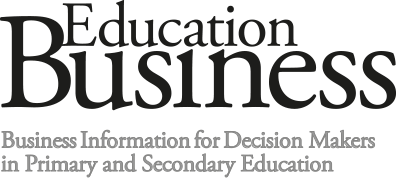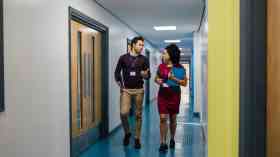A clean school creates a positive learning environment
 Take a moment to think back to when you were at school as a pupil, what comes to mind?
Take a moment to think back to when you were at school as a pupil, what comes to mind?
Personally, I remember the hectic changeover’s between lessons as I ran from one end of the school to the other, the older kids having food fights in the canteen and the water fights on hot summers days. They were the good old days.
We all remember our teachers for the good and the bad. However, did we ever consider the unsung heroes who kept us safe and comfortable in the environment where we learnt out most valuable lessons: the cleaning operatives and school caretakers?
In a report published by the Northern Ireland Education and Library Board, it was found that there are a number of strategic benefits to a clean school: creates a positive learning experience and contributes to the ethos and culture of the school; encourages good hygiene practices; promotes a positive image to parents and reassures of pupil safety; teaches respect for property and environment; reduces hidden costs associated with deterioration of property and expenditure on maintenance.
Minimise risks
In addition to the indirect impact cleaning staff has on the learning experience of pupils, maintaining a good standard of housekeeping at your school will also ensure a safe and hygienic environment for all users of the building, including pupils, staff and visitors.
With many accidents in schools being as a result of slips, trips and falls, it is essential to minimise these risks through maintaining a high standard of housekeeping.
Unlike many other building types, education facilities have to accommodate large-scale movements of pupils, staff and others, often concentrated into short periods of time, such as during lesson changes. With this in mind it is essential that spillages are cleaned up without delay and a “caution: wet floor” sign is used to protect building users to ensure areas are kept free from hazard or obstruction.
Since its establishment over 50 years ago, The British Institute of Cleaning Science (BICSc) has continued to campaign to raise awareness of the requirement for accredited training and standards within the cleaning industry.
Over the years, the Institute has heard many horror stories about cleaning operatives whom, as a result of not receiving accredited training, have endangered themselves and other users of the building. In particular, BICSc has heard stories about operatives who have mixed corrosive chemicals with their hands or have left chemicals within easy reach of primary school children.
For any teacher or parent, it would be their worst nightmare should a pupil be injured as a result of coming into contact with chemicals that should have been stored out of reach.
As this illustrates, it is essential that all cleaning operatives receive accredited training in skills such as chemical competence when preparing cleaning solutions, to ensure health and safety while performing cleaning duties.
Furthermore, without initial accredited training, cleaning operatives will not have been trained in how to clean effectively and safely. For individuals outside of the cleaning industry, who only think about cleaning at the weekend when it’s time to do the dreaded housework, it may seem an obscure concept that individuals need accredited training on how to clean because, after all, we all know how to clean our own homes, right? In some ways this is true, but in fact there is much more to consider within commercial cleaning, such as the risk of cross-infection, correct use of chemicals and health and safety requirements.
Chemical competence
Unlike regular household cleaning, many cleaning operatives are required to use a range of different chemicals, like floor, toilet and window cleaners and polishes. Furthermore, many of these chemicals are purchased in a concentrated form and require diluting. Many of these substances are designed for use in well-ventilated areas or can cause health problems, such as asthma and dermatitis, if used inappropriately.
With many operatives expected to use these chemicals within areas with little or no ventilation, such as toilets or corridors, operatives are not only posing a risk to their own health but also that of the students and staff at the school.
With one in 11 children in the UK suffering from asthma, it is essential that schools do everything within their capabilities to provide a safe environment, this includes clean and hygienic facilities.
Assess substances
By law, employers are required to assess the risk of substances used within a workplace under the Control of Substances Hazardous to Health (COSHH) Regulations 2002. For employees, preventing exposure to harmful substances may require: the adoption of good working techniques that avoid or minimise contact with harmful substances and minimise leaks and spills, including safe storage of materials; providing personal protection equipment, such as gloves or eye protection; ensuring good hand care, for example, remove contamination promptly, wash hands properly, dry thoroughly and use skin creams regularly; ensuring the workplace is well-ventilated.
It is essential that cleaning operatives understand the relevant COSHH data sheets to ensure they are aware of what the hazards and risks are and also of what to do in an accident or emergency.
Before conducting any task, an operative should consult the risk assessment, follow the directions on the product labels, use hazardous substances only for the specified purpose, dilute according to specific instructions, open containers with care and never leave containers open.
Safe storage of
Equipment & Materials
All hazardous substances used for cleaning within schools must be stored appropriately and must not be accessible to the users of the building, ie, not stored in teaching areas, staffrooms or toilets.
By ensuring a well-maintained and E F organised cleaning storage area, operatives and employers can further increase the safety of their operatives by ensuring: hazardous materials are out of the reach of young children but remain easy to access by the cleaning operative (ie, not stored above head height); containers are not left open; there is suitable ventilation where required; warning signs are used correctly; all equipment and materials are labelled correctly; heaviest equipment is stored at the lowest levels; storage areas are dry and not immediately next to a heat source; and hazardous substances are not overstocked.
In addition to ensuring that operatives store equipment and materials effectively, it is also necessary that an operative receive sufficient training about the safe and correct disposal of hazardous products and materials.
By ensuring cleaning operatives understand the requirement to store all equipment and material safely and correctly, employers can confirm the health and safety of all staff and students, including the cleaning operative themselves.
Common complaints
Further to the risks posed by the use of hazardous materials within schools, it is also necessary to establish that equipment and materials are used safely and correctly.
It is essential to make sure equipment is suitable for use (ie, not damaged or faulty) and is used in a safe and effective way (ie, not left out after use or cables left trailing). How many instances have their been in your school where a pupil or member of staff has tripped over a trailing cable or slipped on a wet floor in the bathroom because there was not a “caution: wet floor” sign?
For many, these are common complaints but they are nonetheless preventable through accredited training and knowledge.
Additionally, cleaning operatives are often employed within a workplace that has been designed with other workers in mind (ie, classrooms). This may generate additional challenges or health and safety problems that require the operative to make adjustments for the environment they are working within. For example, many secondary schools are on multilevels so, as a result, operatives are expected to carry equipment (such as vacuum cleaners) up and down stairs. This may
cause an operative serve physical damage, ultimately affecting attendance and the long-term cleanliness of the facilities.
Standards and best practice
When dealing with buildings such as schools, it is essential that all cleaning operatives are provided with the knowledge and skills to allow them to implement colour coding and best practices, such as “from clean to dirty” to minimise cross-infection.
In essence, to clean “from clean to dirty” ensures that an operative always starts with the cleanest area of the environment first, gradually working through to the soiled areas. To illustrate, you would never clean the toilet of a washroom and then continue to the hand basin before you clean the door handle, as you would spread germs from the toilet to all the other areas of the washroom.
Unlike many office buildings, schools often have a wide variety of different facilities that require cleaning, such as classrooms, washrooms, food technology suites and kitchens/canteens. As a result, it is necessary to implement a colour-coding system for cleaning materials and equipment.
The BICSc recommended colour code recommends the use of red materials for general washrooms and bathrooms, red and white materials for higher-risk sanitary appliances, blue for general low-risk areas, green for general food and bar use, yellow for clinical areas and white for site specific or specialist.
Through adopting a colour-code system within the school environment, cleaning operatives are able to minimise the risk of cross-infection by using the correct colour-coded materials within the correct designated areas. As we are aware, the spread of general coughs and colds, and more serious cases of flu, are commonly spread among schoolchildren.
Although children are inherently more vulnerable to common illnesses as their immune systems are still developing, it is possible to reduce the risk by adopting cleaning best practices.
Development of skills
Scientific research demonstrates that student health, attendance and academic performance is improved with clean and well-maintained schools. Furthermore, accredited training and development of skills are crucial to the delivery of a quality service, while allowing operatives to carry out their roles effectively.
Green schools in America have indicated that staff and pupil absence decreases with the introduction of green clean schools. Additionally, through accredited training, employers can reduce staff turnover, increase job satisfaction and foster a good team ethic.
Overall, by improving cleaning standards within schools it is possible to promote a positive learning experience for students, improve health and hygiene within the school and improve the school’s ethos and culture.
Further information
Tel: 01604 678710
www.bics.org.uk
Latest News
18/11/2025 - 09:28
Education Support, the charity dedicated to the mental health and wellbeing of teachers and education staff, has released its ninth Teacher Wellbeing Index.
17/11/2025 - 09:26
Nearly two thirds of Initial Teacher Training providers believe that teachers are not currently prepared to meet the government’s ambition to raise the complexity threshold for SEND pupils entering mainstream schools.
14/11/2025 - 11:04
England’s councils are warning of a "ticking time bomb" in the special educational needs and disabilities (SEND) system, with new data showing deficits that could bankrupt local authorities within three years.
13/11/2025 - 12:14
Event for school leaders, governors and education professionals relocates to the historic Old Billingsgate venue in London.
13/11/2025 - 09:49
The regulations have been set following a second consultation and detailed collaborative working with organisations and people across deaf and hearing communities.







